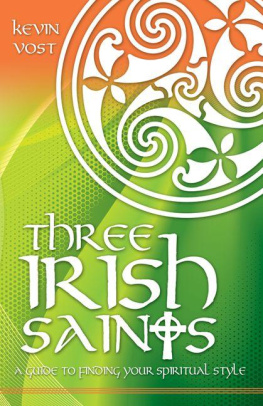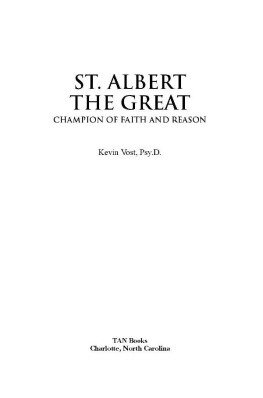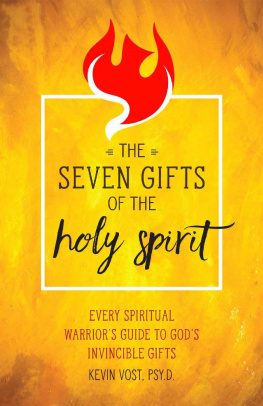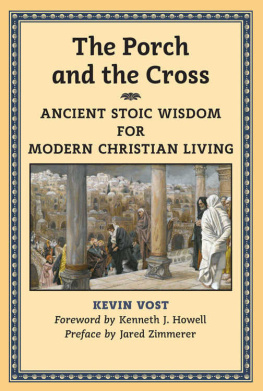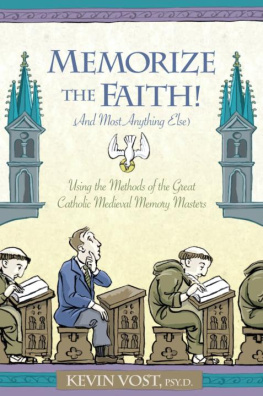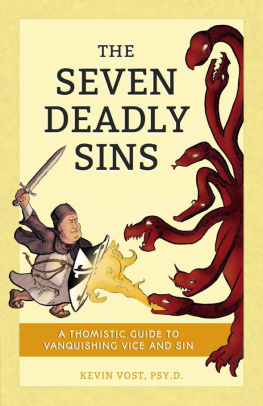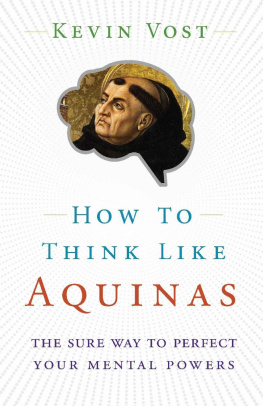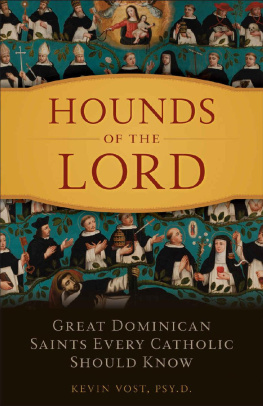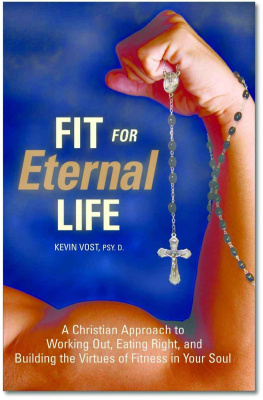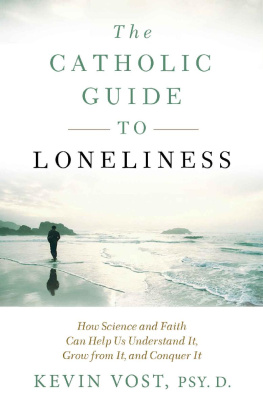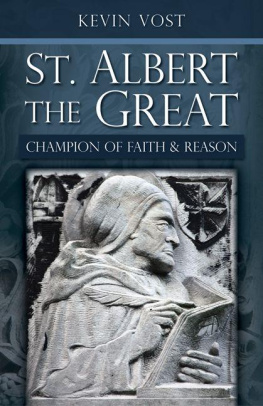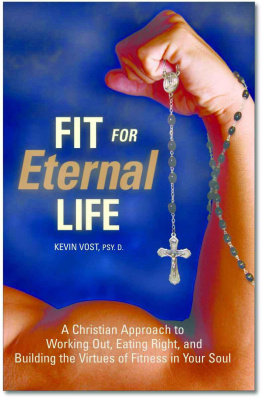THREE
IRISH
SAINTS
THREE
IRISH
SAINTS
A Guide to Finding Your Spiritual Style
Kevin Vost, Psy.D.
TAN Books
Charlotte, North Carolina
2012 Kevin Vost
All rights reserved. With the exception of short excerpts used in articles and critical reviews, no part of this work may be reproduced, transmitted, or stored in any form whatsoever, printed or electronic, without the prior written permission of the publisher.
ISBN: 978-0-89555-720-9
Cover design by Milo Persic, milo.persic@gmail.com.
Cover image: symbol of the Trinity from the Book of Kells , by Milo Persic
Printed and Bound in the United States of America
TAN Books
Charlotte, North Carolina
2012
D EDICATION
I dedicate this tome to the Vosts of my family, immigrants from Britain, St. Patricks first home, and also to the Leahys on moms side, Munstermen (and women) from the town of Killarney in County Kerry, Munster Province, in the southwest of Ireland, not far from the ends of the earth St. Patrick evangelized. With special thanks to the blessed memories of James Henry Vost and Marjorie Margaret (Leahy) Vost, for giving me life and for naming me Kevin.
A blessing upon Munster.
A blessing on their woods.
And on their sloping plains.
A blessing on their glens.
A blessing on their hills.
As the sands of the seas under ships
So numerous be their homesteads,
In slopes, in plains,
In mountains, in peaks,
A blessing. St. Patrick
A B IRD IN THE H AND...
I N THE fifth century AD, St. Patrick was called in a dream by a vision of the Angel Victor to go forth as apostle to the Irish. I too was inspired by a vision, though a waking and this-worldly one, to write this book about what we can learn from St. Patrick and some other glorious Irish Saints. You see, early in 2009 my friend Matt Swaim, Catholic author and radio producer, much in the manner of a modern-day St. Francis of Assisi, had developed a penchant for posting humorous photos of himself with animals on the Facebook page of EWTN/Sacred Heart Radios Son Rise Morning Show . One particular photo showed a rather quizzical looking Mr. Swaim with a baby chick in his outstretched hand. Immediately I was reminded of a picture of an ancient Irish Saint (and my namesake), St. Kevin of Glendalough. Good Kevin was holding a blackbird in his outstretched hand, a depiction of one of many delightful tales well encounter in chapter 1. And that set my brain wheels in motion.
I love the Saints and thank God for them. When I returned to Christ and the Church after twenty-five years in the atheistic wilderness, it was a huge Italian Saint, St. Thomas Aquinas, who led me back to the city of God by showing me through his writings the harmony of faith and reason.
Indeed, as I spied Matts baby chick photo, I already had two books of Saints in the bush, so to speak. I was in the midst of penning a biography of another great Saint, a German and St. Thomass great teacher, St. Albert the Great.
So, Saints were on my mind and in my heart at that time in 2009. We live in communion with a great cloud of witnesses from all nationalities and from all ages in time. They all strive to imitate Christ and they all have their lessons of love to share with us. But if we narrow our focus from time to time to learn about Saints from the same land and era, gleaning both what is common to all of the Saints and what is unique to each, we may unearth great spiritual treasures. (Dare I say, in regards to the Irish, pots of spiritual gold at the rainbows end?)
Now, after Mr. Swaim had called good St. Kevin to mind, my thoughts jumped to more Irish saints. I recall one day in 1987, indeed, it was March, the 17 th to be exact, when my unexpected return to the Church still lay seventeen years in the future. As I buckled my one-year-old son into his car seat, I caught a fascinating story on the real St. Patrick, on National Public Radio of all places.
St. Patrick wasnt even Irish by birth, but despite harsh treatment from his Irish kidnappers, after he regained his freedom, he retained a lifelong zeal to bring Christ back to the Irish. To this day he remains the best known Irish saint. And yet, in the busy tumult of my own life, I learned little else about him in the twenty-two years since Id heard his story.
As I read about Sts. Kevin and Patrick so soon after my immersion in the life and lessons of St. Albert the Great, comparisons and parallels came to the forefront of my imagination and intellect. My book on St. Albert included chapters that focused on him as a remarkable thinker and others that focused on him as a tireless doer. He contemplated God and then acted on it in reaching out to his fellow man. Indeed, a Dominican motto is to share with others the fruits of contemplation.
St. Kevin, as you will see, was a fine contemplator indeed, and few souls will you find who were more the doer than old St. Patrick himself. But in writing on St. Albert, I had also included chapters that focused on him as a lover, for ultimately charity is the highest of the virtues. It inspires and informs both the intellectual virtues that perfect our thinking and the moral virtues that perfect our acts. When the Christian thinks and does, his ultimate goal is to love God and share that love with his neighbor. What Irish Saint is perhaps best classified as a glorious lover of God and neighbor? Well, that is St. Brigid of Kildare, and she will round out our saintly trio.
O N S AINTS OF THE I SLES AND
S PIRITUAL STYLES
Let us be glad and rejoice, and give glory to him;
for the marriage of the Lamb is come,
and his wife hath prepared herself.
And it is granted to her that she should clothe herself
with fine linen, glittering and white.
For the fine linen are the justifications of the saints. Apocalypse of St. John the Apostle 19:78
H OW grand and glorious are those countless righteous deeds of the Saints. Oh, to be in their number! Of course, we all are called to be numbered with the Saints and to clothe the Holy Church with righteous deeds of our own. Thats easier said than done, but the doing is infinitely worth the effort. One way that we can become like those Saints, of course, is through that highest form of flatteryimitation. All the Saints imitate Christ in their own ways and through the flowering of their own unique personalities, arrays of gifts and talents, and places in time and history.
The Irish have been a people with a great love for the history and folklore of their Saints as guides to holiness, and they can boast of (and share with us) a huge array of very colorful and devout saintly men and women. Though each Saint is unique, commonalities are also found. Certain men and women have natural abilities as thinkers or as doers, and as Saints, with the grace of God, they build those abilities to their utmost maximum, lifting us all up along the way. As we begin our journey then, across the waters of the Atlantic to Ireland and across the sands of time to the fifth and sixth centuries AD, we will plan our itinerary with a glimpse at the value of the Saints and of the roles they should play in our lives.
SAINTS PRESERVE US!
Watch an old movie about Ireland over here in the US and youll eventually find some old widow, aghast at some development, crossing herself and exclaiming just that Saints preserve us! Well, they do preserve us, both during and after their lives upon the earth. St. Dominic, on his deathbed, at the height of his powers around the age of fifty-one, told his band of friar preachers that he would be of much greater help to them in Heaven than he had been on Earth. St. Thrse of Lisieux, on her deathbed, in the flowering of her powers at a mere twenty-four years of age, looked forward to spending her life in Heaven doing good for us below.
Next page
